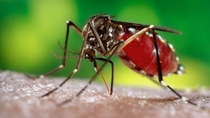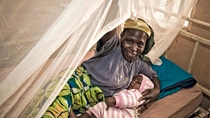Agriculture
Only an integrated approach can stop the spread of Zika
The recent explosion in the number of cases of Zika has alarmed the world and this mosquito-borne disease, once considered mild, is now being connected with congenital birth defects and neurological syndromes. Only an integrated approach to vector management,* including the active involvement of whole communities, can help us to tackle it.

On February 1, the World Health Organisation declared Zika to be a public health emergency of international concern, requiring a coordinated international response. The number of cases has grown dramatically in Latin America and the Caribbean and health professionals strongly suspect a link to the congenital birth defect microcephaly, which causes babies to be born with abnormally small heads. People are, understandably, very scared and governments and health organisations around the world are working desperately to tackle this crisis.
Zika, which was first identified in Uganda in 1947, appeared for many decades to be a fairly mild disease. Initially it spread slowly from Africa to Asia. But as it spread explosively across Latin America last year it appears to have become far more dangerous. There is as yet no vaccine or cure for it. The view of international experts is that the best prevention is to combat the mosquitoes that carry it and prevent them from biting humans in the first place. This means sleeping under mosquito nets, wearing long clothing and using insect repellent, but it also requires action to control and reduce the mosquito population itself, by removing their breeding sites.
The vector that carries Zika is the Aedes mosquito, the same species that is also responsible for spreading diseases like dengue fever and chikungunya. Unlike other mosquitoes, it bites during the day as well as in well-lit homes at night, and it thrives in our man-made urban environment, living and breeding close to humans. Its larvae can be found in any small patch of shady water, from water barrels to puddles – even a screw cap from a beer bottle is enough for Aedes to breed. This makes it very difficult to control. Water collects everywhere in urban areas – on construction sites, in tin cans, piles of old tyres, plant pots and buckets – and these mosquitoes are very inventive in finding places to lay their larvae.

While Aedes thrives on the urban environments we have created, too often people do not know enough about the mosquito and its habitat to take action to control it. Health officials employ several methods to control mosquitoes including biological controls, spraying homes and buildings, fogging larger outside areas, and treating water containers to prevent insect larvae from maturing into adults. But above all, what is required is an integrated approach, combining education, inspection, preventative measures and curative treatments. It is not enough simply to rely on spraying insecticides. When people see the health authorities sweep through an area with fogging machines, this may give a temporary sense of reassurance, but it may be misleading. The fear is gone, but the risk may remain high because people become passive, believing the authorities have dealt with the problem. Within very little time, the mosquito will be back.

Photo: Eduardo Girao
Only the active involvement of the whole community can help to tackle this threat. People must be given the information they need to control mosquitoes and encouraged to take responsibility for their immediate environments, regularly removing or treating standing water wherever it collects around businesses and homes. It requires the involvement of every person, regularly removing potential larval breeding grounds to achieve effective larval source management. Just as important, there has to be a collaboration between the private and public sectors. Governments need to give local authorities proper advice on how to plan, prioritize and execute activities involving insecticides, instead of resorting to emergency fogging.
This integrated, community-based approach has been proven to work in the past. In the 1980s, when malaria was present in epidemic proportions in India, biological and environmental management methods were used that involved the participation of whole communities. Raising awareness, educating people and providing incentives to take effective action helped reduce the mosquito population and, in turn, reduced the threat of malaria infection.
More recently, in an effort to control the spread of dengue fever in Singapore, BASF has supported similar education programs. Participants, who included not just environmental health managers and pest controllers but also contractors, builders, and building facilities managers, were taught about mosquito biology, breeding cycles and habitats as well as preventative measures, integrated monitoring and treatment programs. The “Dengue Warriors”, as they are known, are armed with both the tools and the knowledge to combat the threat from mosquitoes in their part of the world.
The good news is that this kind of coordinated response is now happening in relation to Zika as well. In Honduras, the government recently declared a state of emergency due to the rising number of Zika cases and called on the population to help in the fight. Over 200,000 people from across Honduran society have volunteered to clean up their communities, disinfect residential areas and remove potential breeding sites for mosquitoes.
Only a coordinated, ongoing approach involving the efforts of whole communities can hope to combat this threat. The battle has to be constant – it’s not enough to eradicate mosquito breeding grounds only during the rainy season or only once, it has to continue throughout the year, every year. Once a community is on top of the problem, it cannot let up on efforts or this highly resourceful insect and the dangerous diseases it carries will be back.
About the author
Egon Weinmueller is Vice President for Global Public Health at BASF and has over 30 years of experience in the crop protection industry and public health sector. He sits on the steering committee of the Stockholm Convention working group Global Alliance for Alternatives to DDT, and many Roll Back Malaria working groups. BASF is a committed member of the public health community and is working closely with the World Health Organization, the private and public sectors to help find solutions to control mosquito-borne diseases such as Zika.
* What is a vector?
A vector is an organism, in many cases an insect, which carries and transmits disease-causing pathogens. Vector management is any method to limit or eradicate the vectors which transmit disease. It is the primary public health intervention for reducing the transmission of malaria and other mosquito-borne diseases.




